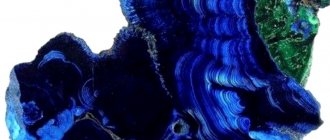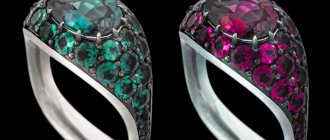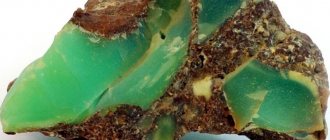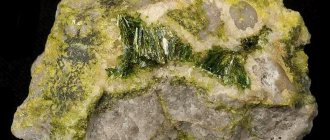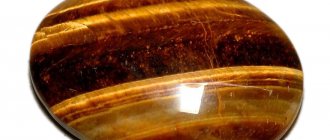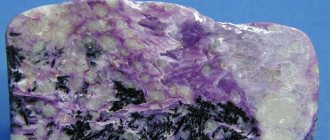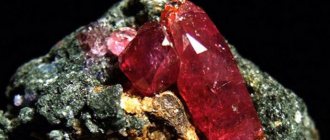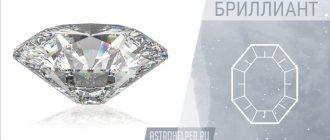| Property | Description |
| Formula | Cu3(СО3)2(ОН)2 or (CuCO3)2 Cu(OH)2 |
| Hardness | 3,5 — 4 |
| Refractive index | nα = 1.730; nβ = 1.758; nγ = 1.838 |
| Density | 3.5—4 g/cm³ |
| Kink | Conchoidal. |
| singonia | Monoclinic. |
| Cleavage | Perfect. |
| Dispersion | Weak. |
| Transparency | Transparent or opaque. |
| Color | Azure blue, dark blue, sometimes to greenish-violet. |
Place of Birth
Azurite from China with large crystals Deposits of azurite can be found all over the world.
It is formed in the near-surface oxidation zones of most copper-sulfide deposits and is found in secondary copper ores along with malachite. Under weathering conditions it is unstable and is easily replaced by malachite. Often in the rock there are banded fusions of azurite and malachite, which are sometimes cut and polished - this variety is called azuro-malachite.
The largest azurite crystals are mined in Tsumeb (Namibia), Katanga (Congo) and Touissite (Morocco); large specimens were also found in Chessy near Lyon (France), Laurion (Greece), Cornwall (Great Britain), Bourra (Australia). The most famous azurite deposit in the USA: Bisbee (in Arizona). There are known deposits in the Altai Mountains (Russia).
Mining locations
Azurite is one of the minerals common in nature. It is found in the same places as other copper ores, as well as native copper or malachite.
The deposits are located in the Russian Urals, Altai (including Kazakhstan), in the USA (Arizona), Australia (Queensland, Burre), France, Great Britain, Greece, as well as in many African states, rich deposits of jewelry and semi-precious stones. Among them are Namibia, Congo and Morocco.
Colors and varieties
In its pure form, azurite is extremely rare, because, attracting other rocks lying nearby, it grows together with them, forming unusually beautiful crystals, striking in a variety of shades and colors: from dark blue and bright blue to rich purple and almost black.
Depending on what rocks the azurite crystals are fused with, they are distinguished:
- azurmalachite is a mineral formed by the fusion of azurite and malachite;
Azurmalachite
- burnite - a rock formed as a result of the fusion of azurmalachite with cuprite;
Burnit
- blue copper - a mineral obtained by merging crystals of pure azurite and chrysocolla;
Blue copper
- azurite in granite is a unique combination that can only be admired at specialized exhibitions. Gray harmoniously intertwines with azure, creating unique patterns on the stone.
Azurite in granite
Varieties and colors
The main color of azyrite is deep blue, darker than the sky. Its color can be compared with the color of the evening sky in the tropics. Certain varieties of azurite are blue-violet, bluish-green, and less often blue. The color depends on the proportional amount of copper in a particular crystal; the more of it, the darker and at the same time brighter it is.
In the same crystal, copper can be distributed unevenly, which gives a shift from blue to dark blue. After polishing, sometimes “pupils” and stripes appear, like onyx, but the contrast is less pronounced.
Azurite and Lapis lazuli - what are the differences?
Even the great Aristotle united the description of these minerals under one name. Many people today believe that this is the same stone.
The names, indeed, go back to a single Persian root. This is where the similarity between the minerals ends. The differences are as follows:
- Azurite has a deep blue color. Natural lapis lazuli does not have this color.
- Lapis lazuli does not have a thick, uniform background because it is diluted by pyrite.
- A cross-section of azurite clearly shows malachite lines; lapis lazuli does not have this characteristic.
- Azurite boils in hydrochloric acid, lapis lazuli does not.
Azurite is harder to find, but it is cheaper than lapis lazuli.
History and origin
Azurite crystals have been known to mankind for a long time, but the description of this stone as an independent mineral was received only in 1824. It was made by the French mineralogist F. Bedan, who also assigned the final name to the stone - azurite, from the French “azur”, which means “azure”.
Azurite
In turn, in French this name goes back to Arabic, and from it to the Persian “lazward”, meaning piercing blue color. Thus, by name, azurite is related to lapis lazuli, with which it is often confused externally.
Both were called azure in the Middle Ages and were used to produce blue tempura (water-diluted) paint. But, unlike lapis lazuli, the coloring pigment from azurite did not require additional color enrichment.
Despite the similarity of names, azurite and lapis lazuli have completely different chemical compositions. Azurite is a compound of copper, and lapis lazuli is a compound of aluminum, sodium and calcium. It has a blue tint.
From a chemical point of view, azurite is much closer to malachite, with which it sometimes combines. It is a secondary copper ore and a raw material for the production of copper sulfate. Azurite is also a geological indicator of the presence of copper or polymetallic ores in the region.
Its other names are mountain blue, copper blue, copper blue or shessilite . In Europe, it is sometimes called shessilite - after the town of Chessy, where one of the largest European deposits is located.
Azurite in section
Mountain blue has been known in Asia for a very long time. It was most widespread in India. According to some esoteric Hindu teachings, azurite has healing powers and provides many opportunities for meditative practices. Therefore, it is important for humans.
Healing properties of azurite
Azurite ring, 925 silver.
In stone therapy, it is believed that the healing properties of the “mountain copper” stone have a direct effect on the frontal and throat chakras. Thus, the stone affects the psyche and mind, as well as the organs of hearing, vision, smell and breathing (up to the lungs and bronchi).
Azurite helps fight diseases of the nervous system, including epilepsy. It has a beneficial effect on people prone to hysteria, melancholy and various neuroses. A pendant with azurite reduces the likelihood of hallucinations in patients with schizophrenia.
In addition, mountain blue cleanses the blood and bile of toxins and wastes and accelerates the healing of bones during fractures and the regeneration of soft tissues during other injuries.
Some lithotherapists recommend this mineral for the treatment of eye diseases and inflammatory processes of the skin.
When treating with azurite, active participation in the process of the patient himself is necessary. He should meditate on a stone placed on the sore spot. The patient should be aware of the basic rules of meditation.
He will need to “feel” the crystal, feel its energy, and then visualize the healing process - for example, imagine the stone “pulling” disease out of the body. It can take the form of a dark spot, blotch or cloud.
After a treatment session, azurite needs to be “recharged”. It must be combined with two hematite crystals and placed under moonlight for an hour.
Scope and scope of use
Many collectors prefer azurite due to its deep blue color, natural luster and crystal shape, which are similar in appearance to lapis lazuli. The substrate itself can be green, gray or brown at the same time, it all depends on their varieties and the place of extraction. Impurities will also play an important role. The collection containing the azurite ore is especially valued. Nature rarely spoils people with such unusual and at the same time rare minerals. Such a deep shade was achieved thanks to the presence of natural inclusions.
Natural stone, which has a deep blue color, boils in hydrochloric acid.
In jewelry, this mineral is often replaced with malachite, as a more resistant copper carbonate. Various pseudomorphoses are also valued by collectors, because the cost of such products is very significant. In this case, any cutting method can be used.
The scope of its application is quite extensive. So, knowledgeable people use it as the main element that improves psychic abilities. It is also used in predictions and fortune telling. On its basis, magic balls and search crystals are made, which are involved in meditation. Can cure many other diseases. Personal contraindications should also be taken into account.
Magical indicators of azurite
Since ancient times, the stone has been used when a person sought to expand his own consciousness. Perfect for developing new abilities and if you need to rethink your own life. At the same time, it does not matter what shape it will be cut into. Belongs to the category of minerals that can influence the human subconscious. However, such thoughts must be beneficial, otherwise the stone will not help.
Based on the legends of Ancient Egypt, with the help of this stone the priests communicated with the gods. The mysteries of Ireland are based on stories that azurite sticks helped to experience previously unprecedented feelings. A small group of these stones should always be kept in the house, but they should be interacted with regularly. Otherwise, they may die.
Helps and protects representatives of such professions as journalists, lawyers, judges and lawyers.
The stone also helps restore justice. If a person deliberately tries to harm another, then the stone will not help and may even hinder such an owner. Suitable for all those who are inclined to become justice. Fraudsters are exposed quickly, so they will not be able to make money with its help, as was the case in ancient times. In a difficult situation, it will contribute to making a balanced and correct decision.
Adding a bit of balance, composure and patience will help all motorists who are stuck in boring traffic jams for a long time.
The stone will bring the necessary luck to its owner even if the dense gem is at home. It is not recommended to use foreign stones that have previously been used by other people.
Interaction with zodiac signs
Numerous legends tell many different stories about azurite jewelry, which are often passed down through generations. It is not used as often in famous brands, but this is most likely due to its extreme rarity. The aura of the stone implies the presence of feminine Yin energy in it. It is recommended to use as talismans and amulets for all air signs of the zodiac (Aquarius and Libra). He makes best contact with Libra, who can always count on his help. Other experts say that it is best suited for Taurus and Sagittarius. Compatibility with other zodiac signs has not been revealed.
The element of stone is water, but Jupiter is considered to be a planet.
Medicinal properties
The stone has various uses, but most often, based on numerous beliefs and legends, it is used to treat headaches (by applying the mineral to the source of inflammation) and cervical ailments. Also used for inflammation of the respiratory tract, hearing and throat. The stone should be used in meditation. Such manipulations are extremely useful both in the morning and in the evening.
The treatment goes like this:
- a mineral or decoration with its addition is applied to a sore spot or the location of an inflamed organ;
- then you should feel the energy of the mineral with your eyes closed;
- ask the stone for help in treatment;
- present the treatment process in great detail;
- visualize the upcoming process.
Azurite jewelry
The lack of hardness, as well as the degree of grain size of azurite, will depend on the location of the crystal deposits. Jewelry with inserts made of this mineral is extremely rare on the open market. They are also difficult to find in nature. It is not recommended to wear them on your hand, since the stone is not able to survive even minor mechanical impact. Its color cannot be called stable either.
The chosen frame for the stone will serve rather a protective function. A properly selected edging will help strengthen the already fragile mineral and prevent it from breaking at the first blow. In ancient times, it was worn only with very expensive outfits that were affordable for the local nobility.
Early on, stone was used as an ornamental material. Azur-malachite, which is not so fragile and no less beautiful, is considered no less beautiful. Regardless of where the stone is mined, it is incredibly fragile.
Magical properties of azurite
A nugget containing azurite and malachite
In terms of energy, azurite is an example of the manifestation of feminine Yin energy. Having faced the influence of negative energy and passing it through itself, the gem makes this energy positive.
The magical properties of azurite were already known to the priests of Ancient Egypt, who used it as an intermediary during sessions of communication with the gods.
Azurmalachite, which combines the energy of two minerals at once, is endowed with double strength. Malachite, which is part of its composition, frees the human body from negative emotions, while azurite normalizes energy flows, reflecting the impact of negative energy.
During meditation, placing azurite on the crown chakra, one gets rid of adversity and anxiety, which are the culprits of strong internal experiences, ultimately finding complete harmony with both the inner and outer world.
A person who is faced with a difficult choice of a further path and does not know which direction to go can put on jewelry with azurite and wait for a hint.
The stone will certainly show you the right path to help you either avoid serious problems or solve them in the most optimal way.
Mediums and psychics highly value azurite balls, which help them in conducting meditations and spiritualistic sessions, during which the gem plays the role of an intermediary between the consciousness of its owner and his subconscious.
The rich blue color of azurite crystals stimulates the crown chakra (the so-called “third eye”), which promotes the development of logical, conceptual and tactical thinking, therefore the impact of jewelry made from this stone is beneficial for lawyers, judges and lawyers.
If the owner of azurite behaves immorally, allowing himself to commit bad deeds, the stone stops giving him its positive energy and may close, and in some cases even split.
Compatibility with other stones
Azurite has powerful energy, so it is combined only with certain rocks. The most favorable combinations:
- With citrine, yellow topaz. This proximity is suitable for amulets, talismans of a couple in love. It will strengthen tender feelings.
- With blue topaz, tourmaline. The combination teaches the owner dispassion, objectivity, and uncompromisingness. These are the same properties of combination with lapis lazuli. A couple of minerals are suitable for a judge, a journalist.
- With hematite. Decorating with these breeds improves memory and reveals secret resources. Recommended for students.
Talismans and amulets
Azurite pendant
Azurite is, first of all, a protective crystal. It will help you live positively and communicate easily. He is taken to important events - business meetings, interviews, castings.
This is a talisman for people who intend to change their lives for the better and attract good luck.
The power of the stone helps to absorb knowledge, so it is suitable for anyone studying, especially for exams.
When a romantic relationship begins, the gem will help bring it to its logical conclusion.
A figurine or azurite crystal on the windshield of a car will be useful for the driver to maintain composure on the road and philosophically endure traffic jams.
Among those for whom the stone is suitable as a professional talisman are journalists, lawyers, and judges. That is, called upon to defend justice.
Areas of application
Azurite
Mountain Blue has a rich, very interesting history, which many fashionistas are not even aware of, believing that the scope of the mineral is limited to jewelry.
During the Middle Ages, azurite was very popular among creative people. Artists used it in painting - crushing it into dust to use as a natural dye. The ancient Greeks and Romans resorted to blue pigment. And under the name “cabbage roll” it was known in the circles of ancient Russian painters.
The stone has found its application in industry and even in pyrotechnics. Here it is used to obtain copper sulfate. This artificially derived substance works very well as an antiseptic when cleaning the house from mold, and also helps plants fight diseases and pests. Returning to fireworks, it is azurite that is responsible for the green-blue tones of decorative lights.
Well, there’s nothing to say about decorations. Rings, earrings and necklaces with such a stone look stylish. They are equally suitable for both evening and business attire - the owner of such jewelry can be confident in its irresistibility.
Where is azurite found? ?
In Russia, azurite is found in: Altai region; Bashkortostan; Orenburg region; Chelyabinsk region.
USA
Laos
Australia
Morocco
In Russia, azurite is found in:
- Altai region;
- Bashkortostan;
- Orenburg region;
- Chelyabinsk region.
The world's richest deposits of azurite are:
- USA;
- Laos;
- Australia;
- Morocco.
Expert opinion
Semenishcheva Polina
Specialist in mineralogy. Graduated from St. Petersburg Mining University.
Azurites of impeccable quality are found in the Teumeb deposit (Namibia). The length of some crystals here reaches 25 cm. (J. Stone “Jewelry Encyclopedia”).
Jewelry with azurite
Azurite in jewelry
In stores you can purchase jewelry such as spectacular beads, earrings, pendants, cufflinks. They are especially popular among the fair sex due to their versatility - they look equally good on both delicate blondes and sizzling brunettes or luxurious brown-haired women.
The price of the mineral in cabochons is minimal and amounts to $3-7 per gram. The larger the mineral, the higher its gemological value. The cost of jewelry depends on the metal in which the stones are framed. So, a silver ring with azurite costs from 30 to 50 dollars.
Crystals and cabochons are of great value to collectors, who often begin collecting minerals after becoming acquainted with azurites that play in all shades of blue. Decorative elements are often made with azure-colored stone that can decorate any interior.
But in this case, it is important to follow some safety measures to preserve the natural stone in its original form - keep it in a dry room away from direct sunlight.
Prices for azurite stone
Azurite with malachite in cross-section
The cost of azurite is quite affordable:
- A polished round pebble with a diameter of 0.8 cm will cost the buyer $10.
- For a stone with a rectangular or square shape and an area of 1 cm2, you will have to pay $10-12.
- Processed azurite of irregular shape, having an area of 3-5 cm2, will cost $15-20.
The cost of a stone depends not only on its size (the larger, the more expensive), but also on the place of extraction, the method of jewelry processing and on the type of inclusions its crystals contain.
Azurite Information
— Advertising —
Azurite is a type of copper ore, in nature it is not as common as lapis lazuli, but is cheaper in cost. Deposits of this mineral are characterized by a high level of copper sulfites, which oxidize to form crystals. Azurite nuggets of cryptocrystalline form. They often form combinations with malachite called azure-malachite.
How to spot a fake
Azurite crystals
Azurite is inexpensive, but it is counterfeited. It is not difficult to distinguish an imitation. It is necessary to compare the description of the natural stone and the control sample:
- The present one has stripes, rings, and patterns arranged randomly. Man-made imitation is more orderly, because natural chaos is difficult to reproduce.
- Pure blue azurite is rare and usually contains traces of malachite.
- The sample is immersed in hydrochloric acid. Nothing will happen to the imitation; the real mineral will boil.
The third way to distinguish a fake is one hundred percent, but purely theoretical.
How to care for stone
Jewelry with azurite
Azurite is able to retain its unique properties and pristine beauty of color only if properly stored and cared for:
- Azurite should be stored in a cool, dry room, not subject to sudden temperature changes and away from direct sunlight. If exposed to high humidity for a long time, this mineral may turn green.
- Being an extremely fragile mineral, azurite needs protection from mechanical stress (strong impacts and falls from a height).
- To avoid scratching products with azurite, they should be stored either in a separate, tightly closed box or in a special bag made of soft material.
- Jewelry containing azurite should be cleaned with a piece of soft, dry cloth. Heavily soiled items can be washed with warm soapy water, remembering to wipe dry. However, contact with very hot water can cause the stone to lose its beautiful shine. The mineral should also be protected from exposure to household cleaning products.
Physicochemical characteristics
Azurite is a brittle mineral.
It is not transparent, but is translucent when you look through it at a light source. It tends to fade and lose brightness in direct sunlight.
- The chemical formula of azurite is Cu3( CO3)2( OH)2 or ( CuCO3)2 Cu( OH)2 .
- Color - dark blue, azure blue, sometimes greenish purple.
- The shine is glassy.
- Transparency - opaque, translucent.
- Hardness - 3,5–4.
- Density - 3.5–4 g /cm3 .
What minerals does it combine with?
Ring and earrings made of silver and azurite
Like any water minerals, the receptive yin energy “mountain blue” is compatible with any other “water” crystals. The most expensive among the possible partners of azurite are emerald and alexandrite.
Less valuable ones include:
- noble opal;
- topaz;
- selenite;
- pearl;
- chrysolite;
- euclase
Water is compatible with Earth, and azurite beads will harmoniously combine with pendants or earrings:
- with lapis lazuli;
- malachite;
- turquoise;
- onyx;
- jadeite;
- nephritis;
- morion;
- crocodile.
It is unacceptable to simultaneously wear azurite with Fire minerals, primarily ruby, diamond, garnet (except uvarovite and demantoid), and heliodor.
It is also undesirable to combine “mountain blue” with Air - all types of quartz, chrysoprase, amethyst, tourmaline, golden beryl and other transparent or “smoky” stones.
Look for where copper lives?️
It is formed during the oxidation of ore sulfides (bornite, chalcopyrite).
Found in oxidation zones of copper deposits (mainly in areas with a dry climate).
It may contain grains of pyrite, making the stone easily confused with lapis lazuli.
Expert opinion
Semenishcheva Polina
Specialist in mineralogy. Graduated from St. Petersburg Mining University.
In Australia, interesting round formations of azurite are found, which are called “azurite suns”.
Azurite and the zodiac signs
In astrology, azurite is considered a symbol of such zodiac signs as Aquarius and Libra. Moreover, the stone itself is identified with the energy of Water and is under the patronage of Jupiter.
He has good compatibility with most signs, among which Libra and Aquarius can be singled out. But, oddly enough, it does not suit Gemini - perhaps Azurite “considers” them to be too superficial people.
| Zodiac sign | Compatibility (“+++” – fits perfectly, “+” – can be worn, “-” – strictly contraindicated) |
| Aries | + |
| Taurus | + |
| Twins | — |
| Cancer | + |
| a lion | + |
| Virgo | + |
| Scales | +++ |
| Scorpion | + |
| Sagittarius | + |
| Capricorn | + |
| Aquarius | +++ |
| Fish | + |
